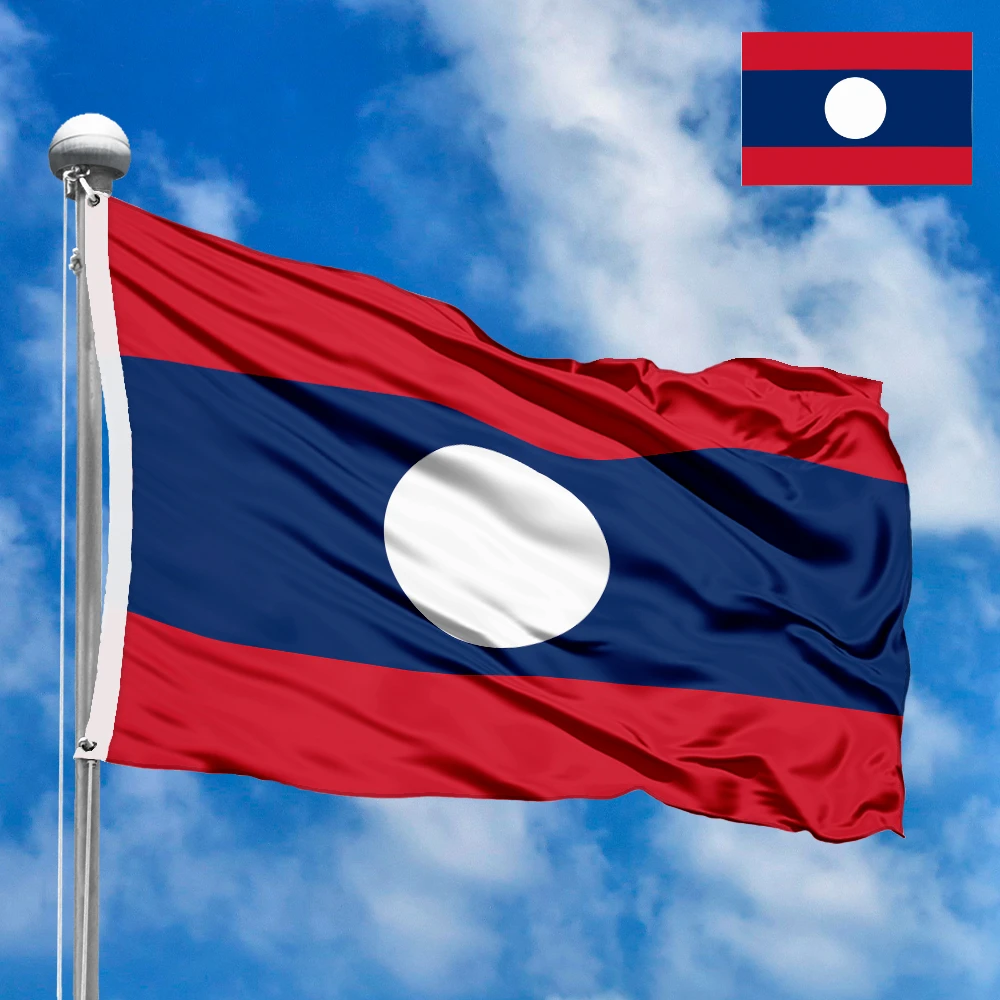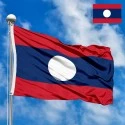The national flag of Laos, a landlocked country in Southeast Asia, is a powerful emblem that encapsulates the nation's journey through history, its geographical significance, and the aspirations of its people. Known for its serene landscapes, ancient temples, and the mighty Mekong River, Laos's flag tells a story of unity, freedom, and the vision of a brighter future for this resilient nation. It stands as a testament to the Lao people's enduring spirit and their unique cultural identity.
Design and Dimensions
The flag of Laos features a distinctive design consisting of three horizontal stripes. The top and bottom stripes are red, while the wider central stripe is blue. Centered within the blue stripe is a large white disc. The proportions of the Lao flag are typically 2:3 (height to width), giving it a well-balanced and aesthetically pleasing appearance.
Symbolism of the Colors and Elements
Each color and element on the Lao flag holds significant symbolic meaning, reflecting the nation's values and history:
-
Red Stripes (Top and Bottom): The red stripes represent the blood shed by the Lao people in their struggle for independence and freedom from foreign domination. This color signifies the sacrifices made by generations of patriots to secure the nation's sovereignty, highlighting their courage and determination. It's a powerful reminder of their revolutionary past.
-
Blue Central Stripe: The broad blue central stripe symbolizes the prosperity and abundance of the country. It represents the fertile lands and the mighty Mekong River, which is the lifeblood of Laos, providing sustenance and supporting its agricultural economy. Blue also signifies the strength of the nation and the richness of its resources.
-
White Disc: The prominent white disc in the center of the blue stripe represents the full moon above the Mekong River. It symbolizes the unity of the Lao people under the leadership of the Lao People's Revolutionary Party and the bright future they collectively strive for. The white color itself signifies purity, honesty, and justice, embodying the moral principles that guide the nation.
History of Creation and Adoption
The history of the Lao flag is deeply intertwined with the country's tumultuous past and its transition from a monarchy to a socialist republic. The current flag design has an interesting origin, dating back to before the establishment of the Lao People's Democratic Republic.
Before 1975, the Kingdom of Laos (under a constitutional monarchy) used a different flag, which featured a three-headed white elephant (Erawan) on a red background, symbolizing the ancient kingdom of Lan Xang ("Land of a Million Elephants").
The current flag was actually designed in 1945 by Maha Sila Viravong, a prominent Lao nationalist, intellectual, and scholar. It was adopted by the short-lived Lao Issara (Free Laos) government in 1945, which sought independence from French colonial rule. After the French reasserted control, this flag was suppressed.
However, when the Pathet Lao (Lao Patriotic Front) gained power and established the Lao People's Democratic Republic on December 2, 1975, they officially adopted Maha Sila Viravong's 1945 design as the national flag. This decision symbolized a clear break from the monarchical past and aligned with the new socialist government's ideals of popular unity and revolutionary struggle. It was one of the few flags of socialist countries that did not incorporate overt communist symbols like a hammer and sickle, reflecting a more nationalistic and less overtly ideological approach.
Significance for the Inhabitants
For the people of Laos, the national flag is a source of immense national pride and a symbol of their hard-won independence and sovereignty. It represents the triumph of their struggle for self-determination and the establishment of a unified, independent state. The flag embodies the collective memory of the sacrifices made by their ancestors and serves as a constant reminder of the nation's journey towards its current political system.
It fosters a sense of unity and shared identity among the diverse ethnic groups that make up the Lao population, reinforcing the idea of a common future under the current leadership. Displayed proudly in public buildings, schools, and during national celebrations, the flag evokes patriotism and reminds citizens of their responsibility to contribute to the nation's peace, prosperity, and development. It is a visual representation of their resilience and their aspirations for continued progress and harmony.
Interesting Facts
-
Pre-Communist Origin: Uniquely among socialist flags of its era, the current Lao flag design predates the communist revolution and was originally adopted by a nationalist movement in 1945.
-
"Land of a Million Elephants": The previous monarchical flag featured a three-headed elephant, referencing the ancient kingdom of Lan Xang, meaning "Land of a Million Elephants," a historical name for Laos.
-
No Hammer and Sickle: Unlike many communist flags, the Lao flag does not feature the hammer and sickle, emphasizing its national character and unique path rather than overt ideological symbolism.
-
Mekong River Connection: The white disc symbolizes the full moon over the Mekong River, highlighting the vital role of the river in Lao life and culture.
-
Designer's Vision: Maha Sila Viravong's design was seen as a minimalist and powerful representation of Lao nationalism and revolutionary aspirations.
-
Rare Re-Adoption: It's rare for a flag suppressed by colonial powers to be later re-adopted by an independent, post-colonial government.
In the demonstration images, full-size flags are shown with proportions of 2:3, and hand-held flags with proportions of 1:2.






 Waving flag
Waving flag
 Sizes:
Sizes:
 Round flag
Round flag
 Sizes:
Sizes:
 Rectangular flag 2:3
Rectangular flag 2:3
 Sizes:
Sizes: